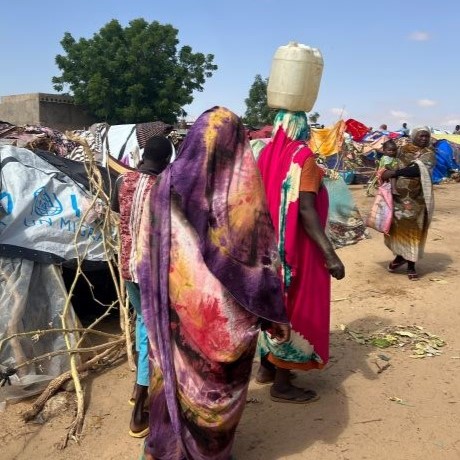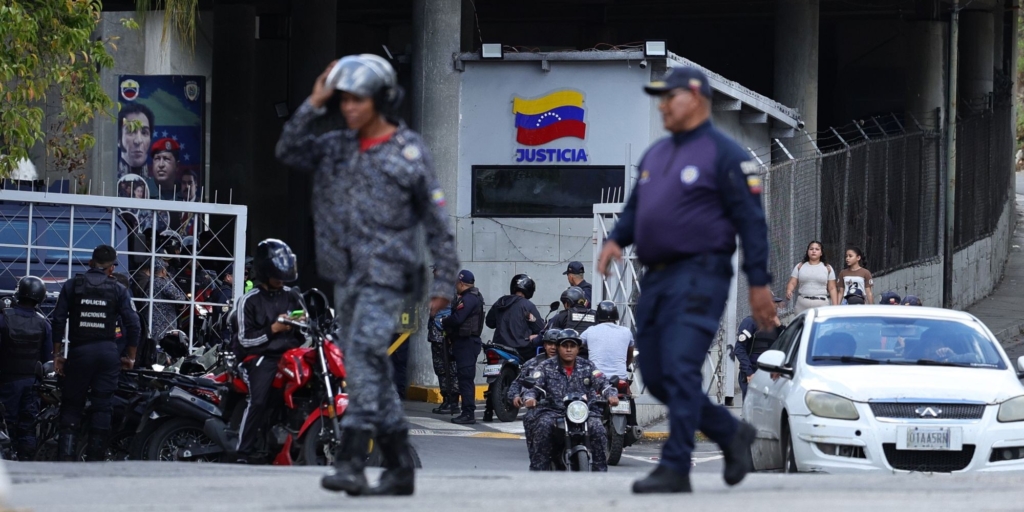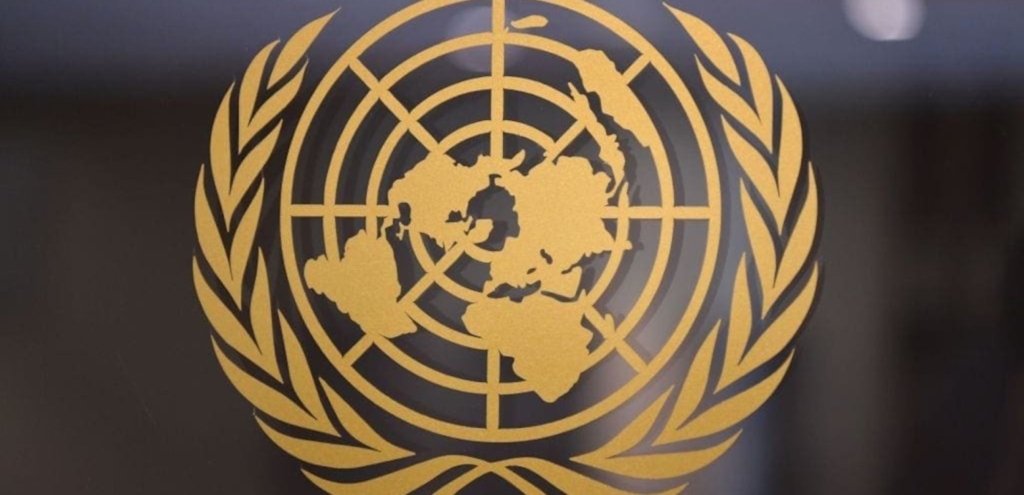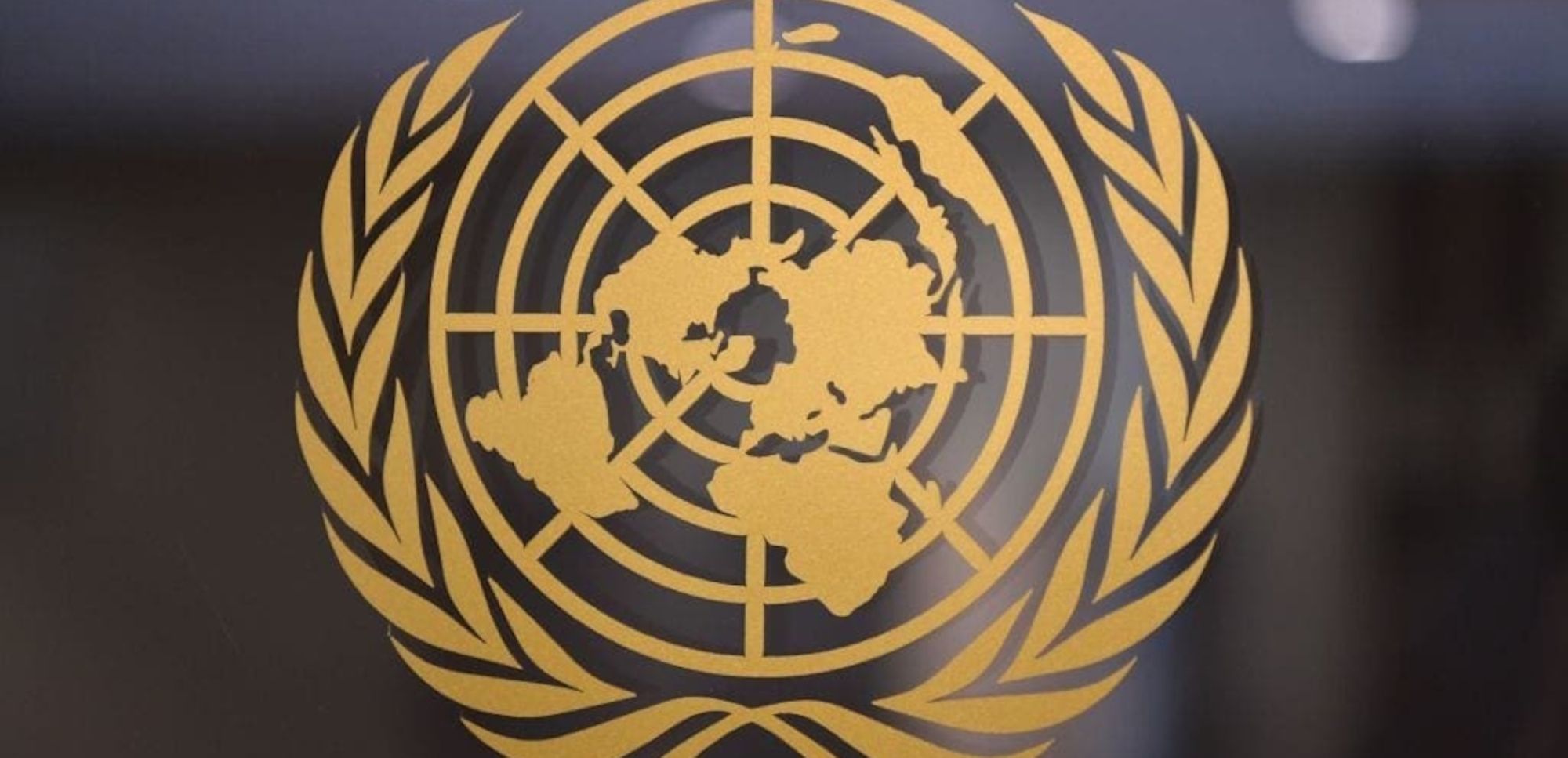Evacuation warnings issued by the Israeli military to residents of the southern suburbs of Beirut and south Lebanon were inadequate, and in some cases also misleading, said Amnesty International today, highlighting that these warnings do not absolve Israel of its obligations under international humanitarian law to never target civilians and to take all possible measures to minimize harm to them.
Under international humanitarian law, parties to a conflict have a clear obligation to take all feasible precautions to avoid, or at least minimize, harm to civilians when carrying out attacks; this includes giving effective advance warning of attacks to civilians in affected areas unless circumstances do not permit.
“The warnings issued by the Israeli military to residents of Dahieh, the densely populated southern suburbs of Beirut, were inadequate. Our analysis shows that not only did the warnings issued by the Israeli military include misleading maps, but they were also issued at short notice – in one instance less than 30 minutes before strikes began – in the middle of the night, via social media, when many people would be asleep, offline or not following media reports,” said Agnès Callamard, Amnesty International’s Secretary General.
“Furthermore, instructing the residents of entire towns and villages in south Lebanon to evacuate is an overly general warning that is inadequate and raises questions around whether this is intended to create the conditions for mass displacement. Regardless of the efficacy of the warnings, they do not mean that Israel can treat any remaining civilians as targets. People who choose to stay in their homes or are unable to leave because members of their household have limited mobility, due to disability, age or other reasons, continue to be protected by international humanitarian law. Israel must at all times abide by its obligations under international law, including by taking all feasible precautions to minimize harm to civilians, wherever they are.”
According to the UN Office for the High Commissioner for Human Rights (OCHA) one quarter of Lebanese territory has been impacted by evacuation warnings.
Our analysis shows that not only did the warnings issued by the Israeli military include misleading maps, but they were also issued at short notice – in one instance less than 30 minutes before strikes began – in the middle of the night, via social media, when many people would be asleep, offline or not following media reports.
Agnès Callamard, Amnesty International’s Secretary General
Effective evacuation warnings
To be effective a warning must be timely and provide information on safe routes and destinations. Amnesty International examined two warnings issued to residents of the crowded urban area of Dahieh overnight on 27/28 September, after the surprise strike that killed Hezbollah leader Hassan Nasrallah. The airstrikes demolished entire residential buildings in the densely populated area. Each warning identified three military targets and requested that residents evacuate a 500-metre radius around that location. The warnings were issued through the Israeli military’s Arabic spokesperson on X (formerly Twitter), at night, without a clear timeline or details on safe routes.
In the two warnings issued to residents of Dahieh, the maps published by the Israeli military alongside the evacuation warnings, covering six different areas, were misleading. In each of these cases the area highlighted on the maps to indicate the danger zone for civilians covered a much smaller area than the 500-metre radius that the Israeli military had advised civilians was the minimum distance civilians should evacuate.
The Israeli military also issued evacuation warnings to residents of around 118 towns and villages in south Lebanon between 1 -7 October, following the start of its ground invasion. These warnings, which included towns that were more than 35 km from the border with Israel and outside the UN-declared buffer zone, do not make south Lebanon a free-fire zone.
To be effective, warnings must give clear instructions for civilians on moving away from military objectives that are going to be targeted. While warnings can, in some circumstances, be general in character, the definition of what constitutes general does not include overly broad warnings that ask civilians to evacuate entire areas (see for instance the 1987 Commentary on Protocol I).
Israel’s warnings in southern Lebanon covered large geographical areas, raising concerns as to whether they were designed instead to trigger mass relocation. Principle 5 of the Guiding Principles on Internal Displacement states that, in all circumstances, authorities and international actors must abide by their obligations under international law so as “to prevent and avoid conditions that might lead to displacement of persons”.
Methodology
Israel’s Operation Northern Arrows began on 23 September with intense aerial bombardment of several areas across Lebanon, including the south, the Bekaa valley and Dahieh, in the southern suburbs of Beirut. According to the Lebanese government, the number of displaced people fleeing Israeli airstrikes has risen to 1.2 million – the vast majority in the last three weeks alone.
Amnesty International reviewed over a dozen evacuation warnings by the Israeli military and conducted interviews with 12 residents who fled Dahieh following the Israeli evacuation warnings on 27/28 September 2024, including al- Laylaki, Hay El Sellom, Hadi Nasrallah highway, and Burj al-Barajneh. The organization also interviewed three residents of villages in south Lebanon.
Amnesty International’s Crisis Evidence Lab mapped the areas covered by Israel’s evacuation warnings to analyse the areas impacted by the strikes.
In its analysis of these warnings, Amnesty International is not seeking at this time to determine whether Israel struck military objectives in their attacks, but rather to investigate whether or not the warnings that Israel issued were effective at protecting civilians and adhered to international law.
Southern suburbs of Beirut: ‘This is not a warning, it’s torture’
Starting at 11:06 pm on 27 September, the Israeli military began to issue evacuation warnings to residents of Dahieh. In the first warning, the Israeli military instructed residents via X (formerly Twitter) to move 500 metres away from three buildings in the neighbourhoods of al-Laylaki and al-Hadath, both of which are densely populated areas, alleging residents there are “located near Hezbollah interests”. The order did not give a timeframe for evacuation.
The map published alongside this warning highlights an area around the buildings to indicate what was supposedly the 500-metre radius that residents should leave. However, the highlighted area in fact only covered approximately a 135-metre radius. While the map showed 30 buildings within the red circle, there are in fact 500 buildings within the 500-metre radius.

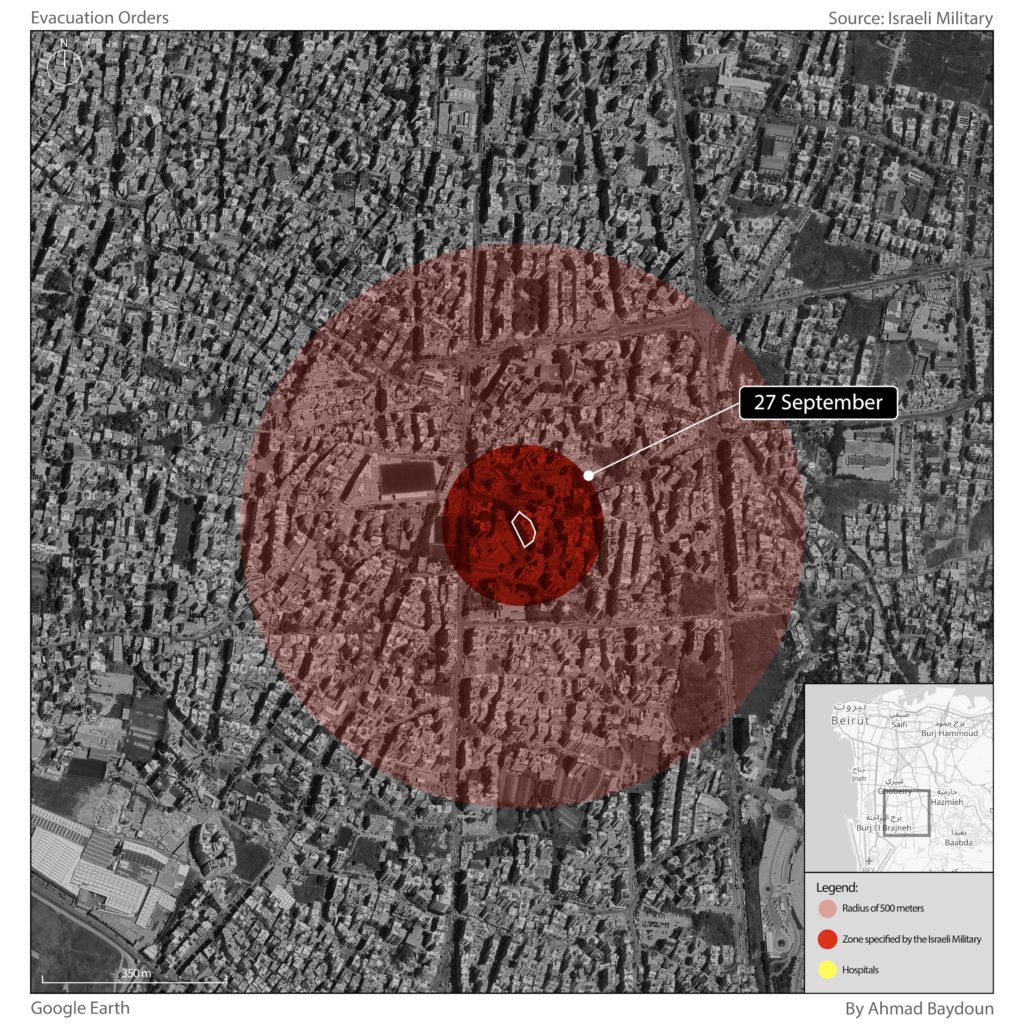
The same is true for the evacuation warnings in the al-Hadath neighbourhood: the areas highlighted on the maps warning residents to stay 500 metres away from the Sheet building and the Al-Salam Complex, showed only approximately 125m and 100m radiuses respectively.
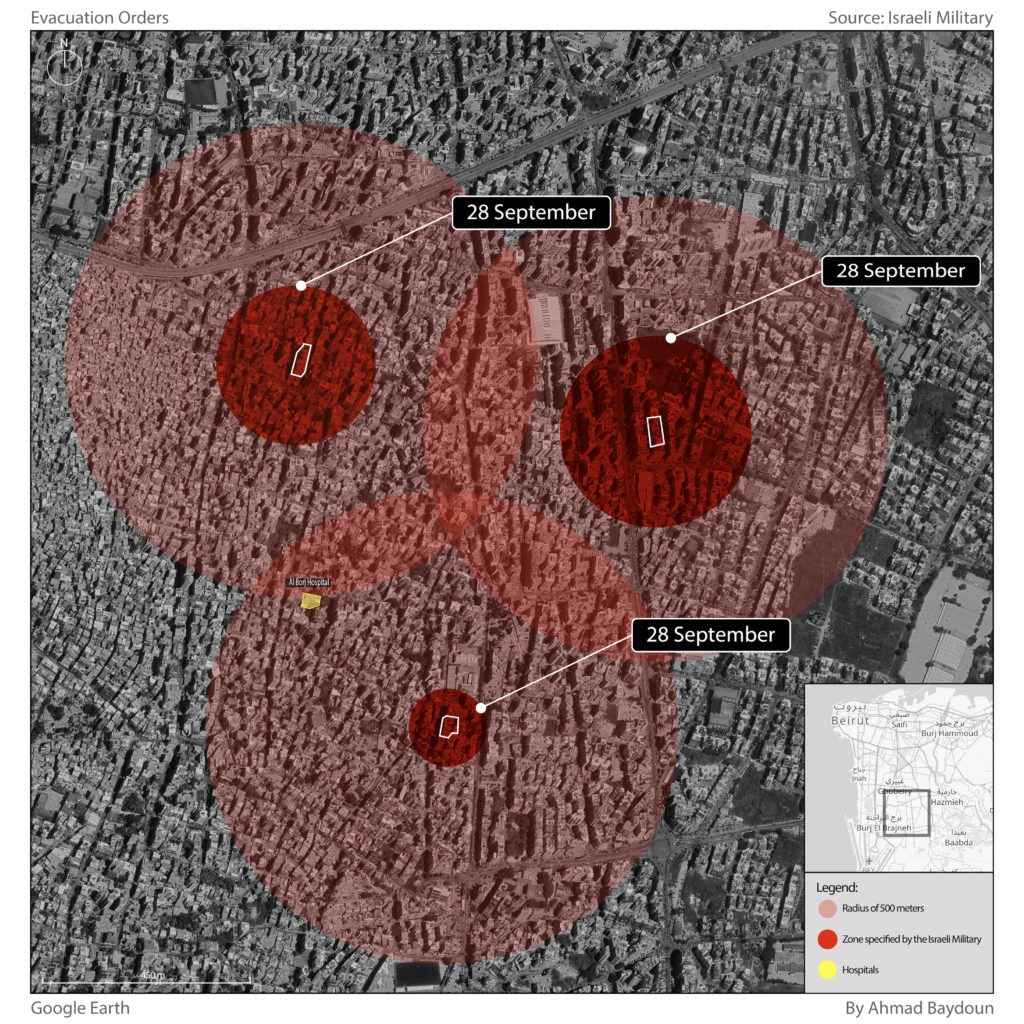
At around 12:36am, just an hour and a half later, local media reported an Israeli strike on al-Laylaki. Over the next hour and 10 minutes, Lebanon’s National News Agency reported 11 further strikes on Dahieh, including on buildings and areas that had not received an evacuation warning.
Fatima, a journalist who lives in al-Laylaki, told Amnesty International that her brother called her at around 11:15pm while she was covering news of the strike on Nasrallah, warning her to leave the area:
“I jumped in the car and drove erratically… I arrived to al-Laylaki and found that everyone was acting as crazily as I was. If people could throw themselves off the balcony to leave faster [they would]. Screaming, running, cars honking, motorcycles, plastic bags…I quickly helped my parents down the stairs to my car, and I only took my cat with me… I currently have no belongings at all.”
Fatima explained that Al-Laylaki is a crowded residential area that remained fully populated until that night because it is on the outskirts of Dahieh and residents did not expect it to be targeted.
Abir, who resides with her mother close to al-Laylaki, told Amnesty International that she could not immediately evacuate her house because her mother is older and sick, and needs to be carried down the stairs: “It was a night from hell. I laid my mother on the floor in the safest room, which is the old bathroom, we hid our heads with our arms [throughout the bombardment].” They were only able to leave a few hours later after a friend helped carry her mother down from the sixth floor.
It was a night from hell. I laid my mother on the floor in the safest room, which is the old bathroom, we hid our heads with our arms.
Abir, whose mother is older and sick and needed to be carried down from the sixth floor to be evacuated
At 3am on 28 September, the Israeli military issued another evacuation warning via X to residents in the neighbourhoods of Burj al-Barajneh and al-Hadath, in Beirut’s southern suburbs, instructing them to move 500 metres away from three other identified buildings. The warning did not state a timeframe for evacuation and maps of the affected areas were similarly misleading, highlighting areas much smaller than the indicated 500 metre radius.
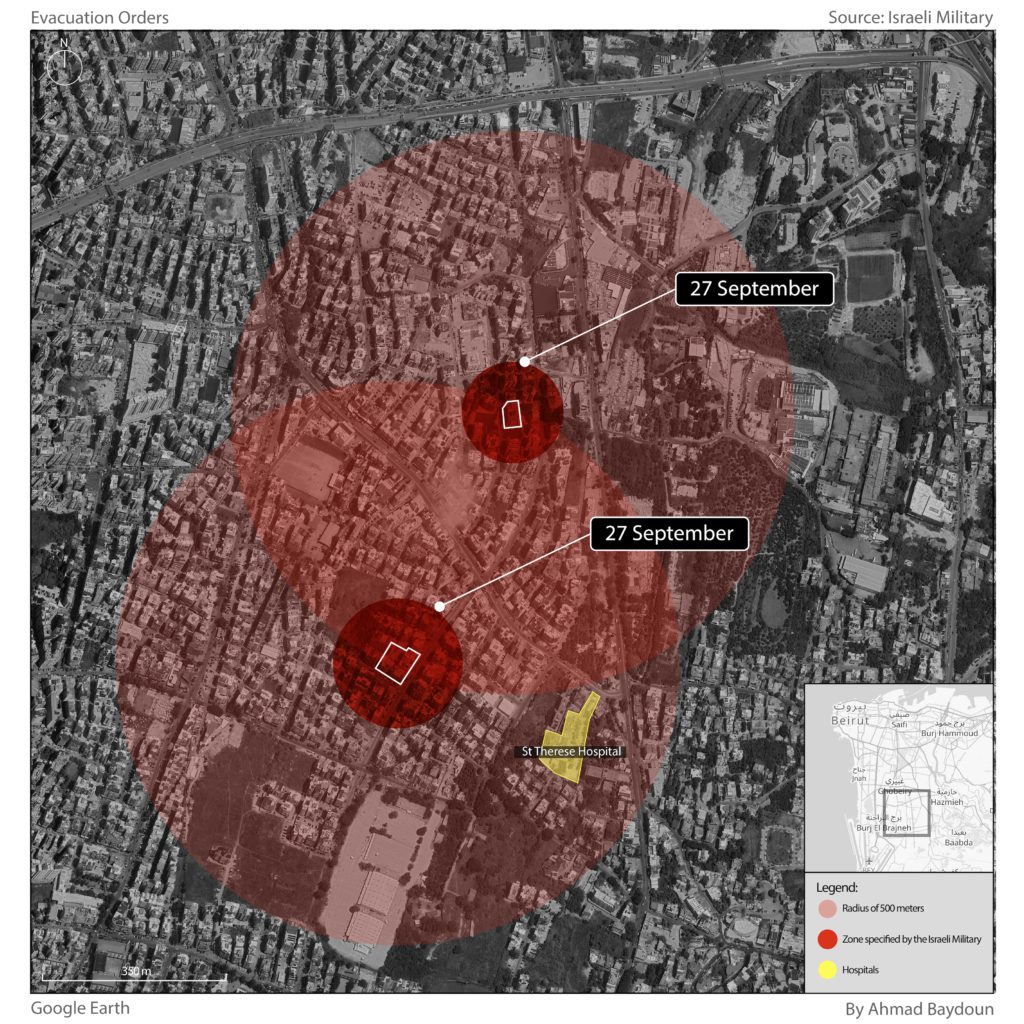
At 5:47 am, the National News Agency reported that Israeli strikes targeted al-Hadath and al-Laylaki as well as the Chouiefat and al-Kafaat neighborhoods in Beirut’s southern suburbs, which were not listed in the evacuation warning. Local media reported continued strikes on Beirut’s southern suburbs throughout the day.
Taghreed, a resident of Hay el-Sellom, said that she had not heard about the Israeli warning and took the decision to flee after the major attack that killed Hassan Nasrallah. “We were hiding and couldn’t reach the television. I don’t have social media so I don’t know what the Israelis said,” she told Amnesty International.
Ahmad, a resident of Burj al-Barajneh, also said that he made the decision to leave Dahieh immediately after the strike that killed Nasrallah, as he lives with his elderly parents. “While we were still stuck on the road out of Dahieh, with all the ambulances trying to prioritize the wounded people, we heard about the warning on the radio in the van. I felt bitter. This is not a warning; it’s torture. It’s a sadistic game: ‘we will kill you and your family soon. Show us how you can escape’.”
On 30 September 2024, the Israeli military issued a warning to evacuate from the surroundings of residential buildings in al-Laylaki, Haret Hreik, and Burj al-Barajneh. The Israeli military launched a series of strikes just 30 minutes later. Similarly, on 3 October 2024, at 10:51 pm, the Israeli military issued an evacuation warning for the residents of Burj al-Barajneh, urging them to leave immediately. Local media reported a “heavy strike” minutes after the evacuation order was issued, and at least four strikes by 11:30 pm.
Under international law, Hezbollah and other armed groups must, to the extent feasible, avoid locating military objectives, including fighters, ammunition, weapons, and military infrastructure, in or near densely populated areas. However, the presence of military objectives in populated areas does not absolve Israeli forces of their obligations under international humanitarian law to avoid indiscriminate or disproportionate attacks as well as to take all feasible precautions to spare all civilians, including civilians who fail to leave the area after an evacuation warning. Failure to provide effective advance warnings of attacks which may affect civilians, unless circumstances do not permit, and not taking all other feasible precautions to protect civilians, constitute violations of international humanitarian law.
En masse evacuation warnings to residents of south Lebanon
On 1 October, the Israeli military issued two evacuation warnings to residents of south Lebanon. The first, at 9:21am, instructed residents not to move vehicles south of the Litani River “until further notice,” alleging that Hezbollah is using “the civilian environment and the population as human shields.”
At 12:18 pm, the Israeli military instructed residents of over 25 towns across southern Lebanon to evacuate and move north of the Awwali River, some 58 km from the border with Israel and about 30km farther than the Litani River, which marks the UN buffer zone created after the 2006 war.
On 2 October 2024, at 9:11 am and then at 11:15 am, the Israeli military issued warnings for a further 24 towns and villages across southern Lebanon, telling residents to “save their lives and leave their homes immediately,” ordering them to move north of the Awwali River, and saying that any movement south could expose them to danger. The Israeli military issued a similar warning at 12:49 pm on 3 October for a further 25 towns and villages, at 9:11 am on 4 October for a further 35 villages, and at 12:58 pm on 7 October for 25 additional villages.
None of the “orders” offered safe and effective evacuation, just instructing residents to leave “immediately”.

Amnesty International’s concerns about the warnings to civilians in south Lebanon are heightened by some statements from Israeli political and military leaders indicating that they considered Lebanese civilians and property to be legitimate targets. Israeli Prime Minister Benjamin Netanyahu has said on 27 September 2024 there is “a missile in every kitchen, a rocket in every garage”. The Israeli Education Minister said on television on 21 September 2024 that there was no difference between Hezbollah and Lebanon and that Lebanon “would be annihilated”. The Israeli Defense Minister has also previously warned in June 2024 that Israel is capable of returning Lebanon “to the stone age”.
“The massive loss of life in Lebanon in recent days raises fears that Israeli forces may be flouting their obligation to take all feasible precautions to minimize harm to civilians wherever they are, including through issuing effective warnings. Having spent the last 12 months investigating Israel’s war crimes in Gaza, Amnesty International is extremely concerned that Israel may be seeking to replicate the approach it followed in Gaza, resulting in unprecedented civilian harm,” said Agnes Callamard.
The south Lebanon warnings and the instructions that vehicles do not travel south of the Litani River also raise serious concerns over civilians’ access to essential supplies and services, including food, medication, healthcare and fuel.
The mukhtar of Rmeich, a village south of the Litani river close to the border with Israel, which did not receive an evacuation warning but is within the area in which Israel has said vehicles are prohibited from travelling, told Amnesty International that supplies in the town were rapidly dwindling. “The area is going to become destitute. How can we continue? It’s like they want to displace us,” he said.
The conditions being created by Israel’s actions in south Lebanon risk forcibly displacing the majority of the civilian population there.
One of the towns in southern Lebanon that the Israeli military warned must be evacuated is Ain Ebel, where the majority of residents are Christian and have no known affiliation with Hezbollah.
Rakan Diab, an Ain Ebel resident, told Amnesty International that residents of the village were surprised when Ain Ebel was included in the Israeli military’s evacuation warning on X (formerly Twitter) on 1 October. Shortly afterwards, the mayor of the village received a call from an individual purporting to be a member of the Israeli military warning residents to flee within around 45 minutes because there were weapons in the village.
“People panicked… we needed to pack and leave immediately,” he said explaining how the majority fled to the nearby village of Rmeich and the Lebanese army and the Lebanese Red Cross facilitated safe passage for a convoy of around 100 cars from Rmeich to north of the Awwali River.
“Amnesty International is calling on Israel’s allies, including the United States, to suspend all arms transfers and other forms of military assistance to Israel due to the significant risk that these weapons could be used to commit or facilitate serious violations of international law. The organization is also calling for a suspension of all arms transfers to Hezbollah and other armed groups in Lebanon,” said Agnès Callamard.
Background on Israel’s Operation Northern Arrows
Israel’s Operation Northern Arrows began on 23 September. During the first day, Israeli forces carried out at least 1,600 strikes in areas across Lebanon, killing more than 500 people and injuring over 1800 in the first 24 hours. Hezbollah also launched more than 200 rockets towards Israel that day, with around 10 people sustaining shrapnel or debris wounds.
Hezbollah and Israel have been engaged in ongoing cross-border hostilities since the group launched attacks into northern Israel following the outbreak of hostilities between Israel and the occupied Gaza Strip in October 2023.
Israeli attacks on Lebanon since 7 October 2023 have killed at least 2083 people, according to the Lebanese Ministry of Health. More than 1.2 million people have been displaced in Lebanon, and at least 400,000 have crossed the border to Syria.
Many of Hezbollah’s rockets are unguided and cannot be aimed at a specific target. Firing inherently inaccurate rockets into areas where civilians are present are indiscriminate attacks, and thus violate international humanitarian law. Direct attacks on civilians and indiscriminate attacks which kill or injure civilians constitute war crimes.
Since 8 October 2023, Hezbollah and other armed groups have launched thousands of missiles at northern Israel, killing 16 civilians. A further 12 civilians, all children, were killed on 27 July in an attack on Majdal Shams in the occupied Golan Heights. Around 63,000 residents of northern Israel have been evacuated since 8 October.
In one Hezbollah attack, on 12 November 2023, an anti-tank missile hit a group of electricity company workers who were doing infrastructure work near Dovev. One worker was killed in the attack, and another lightly injured.
In another attack, on 9 July 2024, two civilians were killed when a missile hit their car while driving on highway 91 in the Occupied Golan Heights. In a statement released that day, Hezbollah took responsibility and said that it targeted the nearby Nafah military base in response to the assassination of one of its members.
Header image: Smoke rises from the site of Israeli artillery shelling on the southern villages of Adeisseh and Kfar Kila along the border with Israel on October 1, 2024. Photo by AFP via Getty Images.















